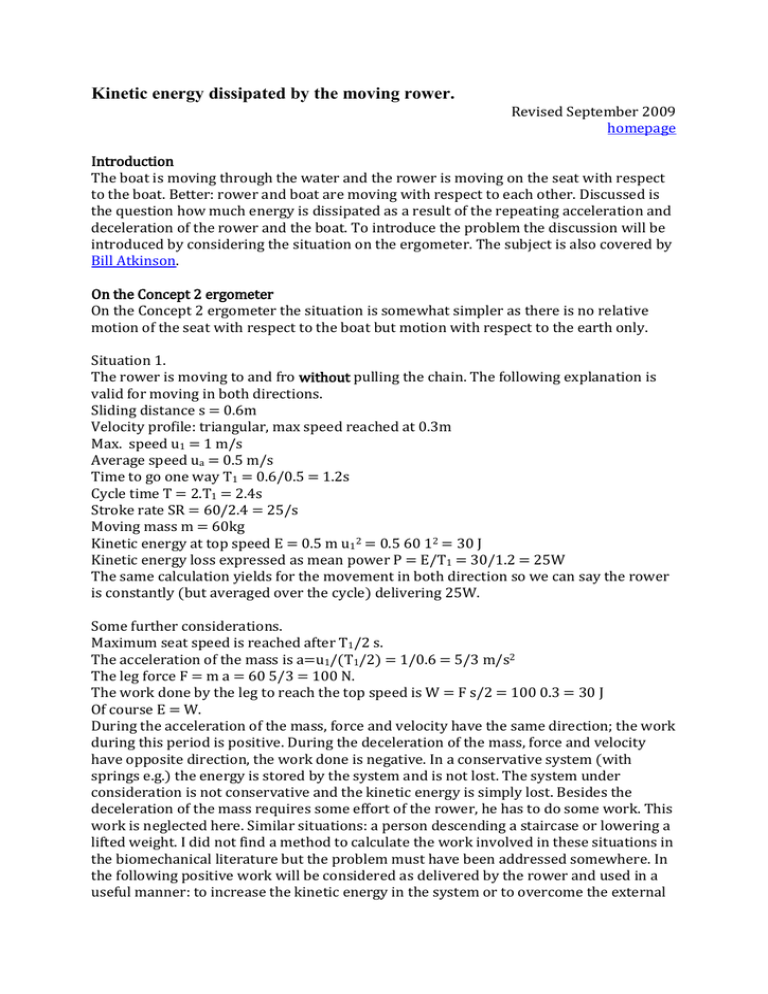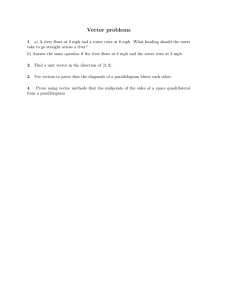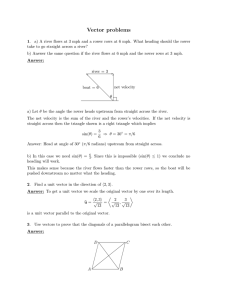Kinetic energy dissipated by the moving rower.
advertisement

Kinetic energy dissipated by the moving rower. Revised September 2009 homepage Introduction The boat is moving through the water and the rower is moving on the seat with respect to the boat. Better: rower and boat are moving with respect to each other. Discussed is the question how much energy is dissipated as a result of the repeating acceleration and deceleration of the rower and the boat. To introduce the problem the discussion will be introduced by considering the situation on the ergometer. The subject is also covered by Bill Atkinson. On the Concept 2 ergometer On the Concept 2 ergometer the situation is somewhat simpler as there is no relative motion of the seat with respect to the boat but motion with respect to the earth only. Situation 1. The rower is moving to and fro without pulling the chain. The following explanation is valid for moving in both directions. Sliding distance s = 0.6m Velocity profile: triangular, max speed reached at 0.3m Max. speed u1 = 1 m/s Average speed ua = 0.5 m/s Time to go one way T1 = 0.6/0.5 = 1.2s Cycle time T = 2.T1 = 2.4s Stroke rate SR = 60/2.4 = 25/s Moving mass m = 60kg Kinetic energy at top speed E = 0.5 m u12 = 0.5 60 12 = 30 J Kinetic energy loss expressed as mean power P = E/T1 = 30/1.2 = 25W The same calculation yields for the movement in both direction so we can say the rower is constantly (but averaged over the cycle) delivering 25W. Some further considerations. Maximum seat speed is reached after T1/2 s. The acceleration of the mass is a=u1/(T1/2) = 1/0.6 = 5/3 m/s2 The leg force F = m a = 60 5/3 = 100 N. The work done by the leg to reach the top speed is W = F s/2 = 100 0.3 = 30 J Of course E = W. During the acceleration of the mass, force and velocity have the same direction; the work during this period is positive. During the deceleration of the mass, force and velocity have opposite direction, the work done is negative. In a conservative system (with springs e.g.) the energy is stored by the system and is not lost. The system under consideration is not conservative and the kinetic energy is simply lost. Besides the deceleration of the mass requires some effort of the rower, he has to do some work. This work is neglected here. Similar situations: a person descending a staircase or lowering a lifted weight. I did not find a method to calculate the work involved in these situations in the biomechanical literature but the problem must have been addressed somewhere. In the following positive work will be considered as delivered by the rower and used in a useful manner: to increase the kinetic energy in the system or to overcome the external friction. Negative work will be considered as internal dissipation, useless but not to be delivered by the rower. As found above: without pulling the chain the rower is producing 30J per cycle or an average power of 25W. Situation 2 This is the common situation. When the rower moves away from the flywheel he pulls the chain and when he returns (recovery) no interaction with the flywheel exists. The recovery equals Situation 1. During the recovery (same parameters as above) the rower produces 25W and this output is not recorded on the monitor. During the drive phase the rower maintains a pull on the chain. In the first part of the drive the forces exerted by the rower are used to accelerate his own body and to pull the chain. His leg force is the sum of the chain pull and the force necessary to accelerate his body. In the second phase of the pull his body is decelerated by the chain pull. His leg force is the chain pull minus the force to decelerate his body. This means that under normal conditions during the whole drive the rower’s power is positive and all the energy (power) he delivers is recorded on the monitor. The figure below shows the forces on the rower (greyed rectangle) and m.a is the inertia force mass times acceleration (deceleration). Fchain Fchain m.a m.a Flegs Flegs Flegs = Fchain + m.a Flegs = Fchain - m.a In this situation the rower produces 30J during the recovery or 30/2.4 = 12.5W more than the monitor indicates. This is a rough estimate. Usually the times for the recovery and the drive are different. In the boat Situation 1. The situation in the boat is different. First we consider the boat and rower as a system without external forces. This is u m2 U m1 m1 = mass of boat and part of the mass of rower fixed to the boat [kg] m2 = moving mass of rower [kg] u = speed of m2 with respect to m1 [m/s] U = speed of m1 [m/s] with respect to earth At the start of the seat motion u = 0 and U = Uo, the maximum value of u is u = u1, and the corresponding speed of m1 is then U = U1 (minimum value). After the seat has stopped again U = Uo, this follows from the principle of conservation of momentum. The kinetic energy in the system before and after the seat motion (motion of m2) is the same because the velocities are the same. When u reaches its maximum value, the kinetic energy in the system reaches its maximum values. This difference in the amount of kinetic energy has to be delivered by the rower to the system and is then lost: dissipated in the muscles and articulations of the rower as in the case of the ergometer but the amount lost energy is different as will be shown. Momentum at the start and at the end of the seat motion: Q0 = (m1 + m2).U0 Momentum at maximum value of u: Q1 = m1. U1 + m2.(U1 + u1) Conservation of momentum: Q1 = Q0 or m1.U1 + m2.(U1 + u1) = (m1 + m2). U0 this yields: m m m u Kinetic energy at the start (and at the end) of the seat motion is: m m Kinetic energy when u = u1 is: m And expanded: m u m m m The difference Δ u m 1 m u m m m - Eo is after some (and tedious) algebraic manipulation m m m m Remark: In this expression m1 an m2 appear in the same way. Interchange of m1 and m2 does not influence the result U0 and U1 are absent In this derivation was u>0. When u<0 the result appears to be the same. For the single scull we take as for the person on the ergometer for the mass moving with the seat m2 = 60 kg. The mass moving with the boat is the remaining mass of the rower plus the mass of the boat or m1 = 30 kg. When u1 = 1 m/s again, the energy loss is now: Expressed as average power this is 20/1.2 = 16.7W Compared with 30J or 25W on the erg. The mass distribution is that of a “normal” boat When a roll rigger is considered and we assume m1 = 60 kg and m2 = 30 kg the result is the same. For the type of energy loss as discussed here the roll rigger does not offer any advantage. Situation 2 As situation 1, but rower is pulling the oars. For the return it does not make any difference. For the drive it may be expected that there is a situation as on the erg when pulling the chain. Force and (relative) velocity have the same direction. The rower is during the whole drive generating power. Kinetic power is transferred to the oar, no power is dissipated. The next figure is a result of the simulation model. (Different parameters as used above). It shows the leg force during the whole cycle. Only in the second part of the return force and velocity have an opposite sign but the force is here very small. A very small amount of energy is dissipated. In the small transition zones the situation is not quite clear but that is for this discussion less important. Conclusion In rowing in racing shells the energy loss due to momentum transfer is small. This is another conclusion than Atkinson’s. For a mechanical system, simpler than rowing it is shown that energy loss due to momentum transfer can reach non-negligible values. Click here. Fleg 1000 800 force [N] 600 400 200 0 -200 0 0.2 0.4 0.6 0.8 1 time [s] 1.2 1.4 1.6 1.8 2 drive second part of return first part of return return Leg force during drive and return




